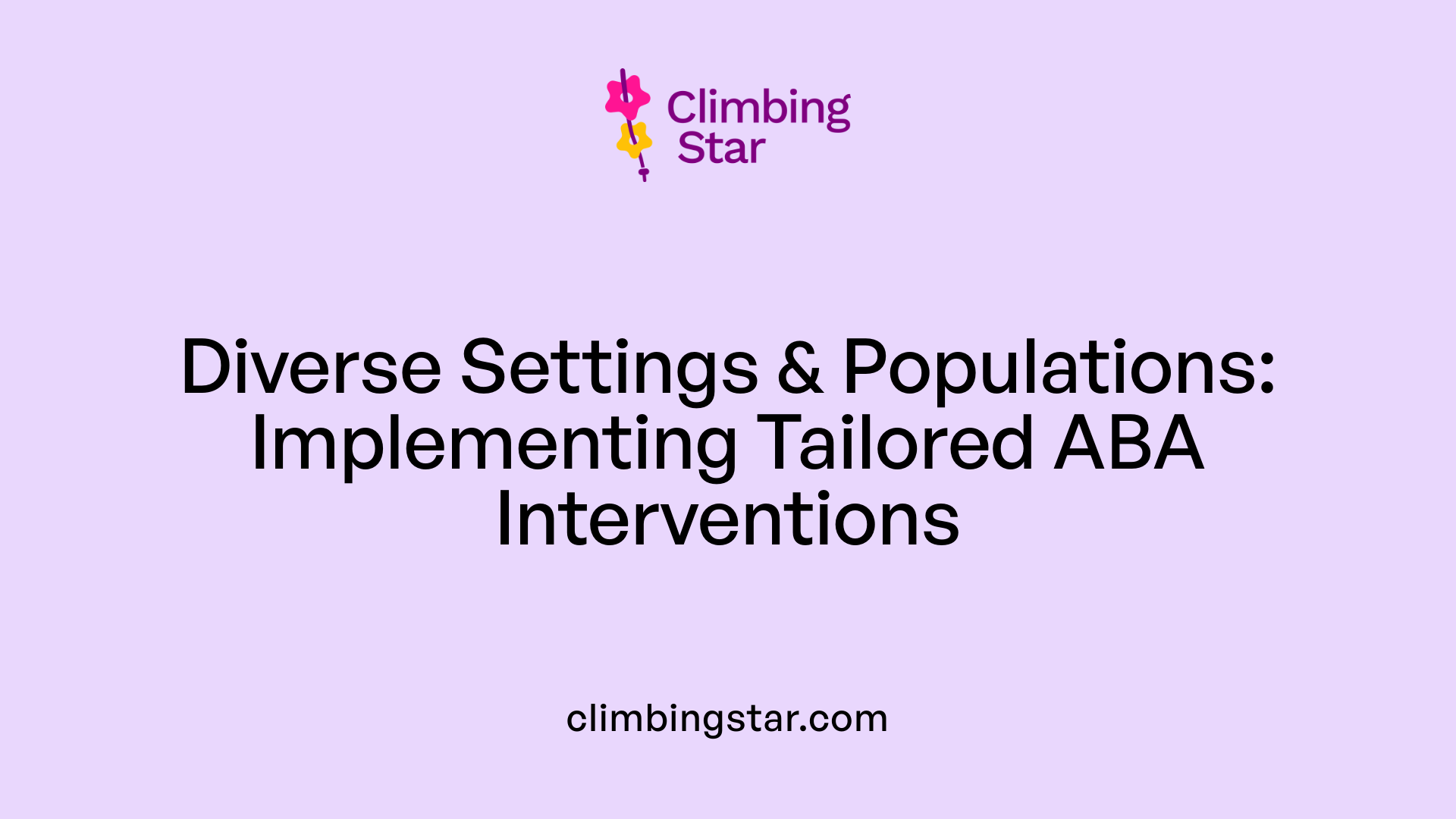Defining ABA Therapy and the ABA Therapist
Applied Behavior Analysis (ABA) therapy represents a scientifically validated approach designed to improve essential life skills and reduce challenging behaviors in individuals with autism spectrum disorder (ASD). ABA therapists play a critical role in this process, providing specialized interventions that are tailored to each individual's unique needs. This article explores what an ABA therapist is, the methods they use, their qualifications, and the challenges families might encounter when seeking ABA services.
What is ABA Therapy and How Does It Help Individuals with Autism?

Definition of Applied Behavior Analysis (ABA) Therapy
Applied Behavior Analysis (ABA) therapy is a scientifically grounded intervention that applies the principles of learning and behavior to improve specific skills. It is particularly effective for individuals with autism, aiming to increase helpful behaviors and reduce harmful ones by understanding the connection between environmental events and behavior.
Goals of ABA Therapy in Autism
ABA therapy focuses on enhancing communication, social skills, daily living, and learning capabilities. Its primary goal is to foster independence and improve the individual's ability to navigate personal and professional aspects of life. By setting measurable and individualized objectives, ABA supports children and adults in acquiring essential skills progressively.
Techniques Used in ABA Therapy
Key techniques include positive reinforcement, where desirable behaviors are encouraged through rewards, and antecedent-behavior-consequence analysis, which helps identify triggers and outcomes to modify behavior effectively. Therapists also use prompting, fading, behavior chaining, and modeling to teach new skills. Constant data collection monitors progress and guides timely adjustments of the therapy plan.
Individualized, Structured, and Play-Based Approaches
ABA programs are tailored to each individual following comprehensive assessment. These programs break skills into small, manageable steps delivered through structured sessions often combined with play-based or naturalistic methods that align with the individual's interests. This personalized method ensures therapy is engaging and effective.
Overall Impact on Independence and Skill Development
Through consistent practice and reinforcement, ABA therapy significantly improves behavioral and practical skills. This empowerment enables individuals with autism to participate more fully in social, academic, and community settings. Early intervention with ABA has been particularly shown to enhance developmental outcomes, supporting long-term independence and quality of life.
Who Are ABA Therapists and Providers?

Qualifications of ABA Therapists
ABA therapists are highly trained professionals who typically hold at least a master's degree in fields such as education, applied behavior analysis, or psychology. They must complete specific coursework, accumulate supervised practical experience, and pass the rigorous Board Certified Behavior Analyst (BCBA) exam to earn their certification. This qualification ensures they are equipped with the scientific knowledge and practical skills needed to develop and implement effective behavioral treatment plans.
Board Certified Behavior Analyst (BCBA) Credentials
A BCBA is a licensed clinical therapist specially trained in ABA principles. They design, oversee, and adjust therapy programs tailored to each individual's needs. Their responsibilities include conducting behavioral assessments, creating evidence-based intervention plans, and supervising therapists and Registered Behavior Technicians (RBTs).
Roles of Registered Behavior Technicians (RBTs)
RBTs are trained professionals who implement ABA therapy sessions under the supervision of a BCBA. They directly work with clients during therapy, applying techniques such as positive reinforcement and behavior chaining. While they do not design therapy programs, their role is crucial in executing treatment and collecting data to monitor progress.
Settings Where ABA Therapy Is Provided
ABA services are delivered in various environments including homes, schools, clinics, hospitals, and community settings. This versatility allows therapy to be tailored to the individual’s daily life, promoting skill acquisition and behavior improvement across contexts.
Importance of Accredited Providers
Choosing an accredited ABA provider, such as those recognized by the Behavioral Health Center of Excellence (BHCOE), assures families of high-quality, evidence-based care. Accreditation confirms that providers adhere to ethical standards, use validated methods, and maintain ongoing professional development.
Insurance Considerations
Insurance coverage for ABA therapy varies widely. Many private insurers and Medicaid programs cover ABA when it is deemed medically necessary, often requiring a formal diagnosis of autism along with documented treatment plans. Families should verify coverage details and provider networks to optimize benefits and reduce out-of-pocket costs.
Educational Path and Certification for ABA Therapists

What are the educational requirements for becoming an ABA therapist?
Becoming an ABA therapist typically involves at least six years of education, including earning undergraduate and graduate degrees. The usual path starts with an undergraduate degree in psychology, education, or a related field, followed by a master's degree specializing in applied behavior analysis, education, or psychology.
What supervised experience and training are needed?
During graduate studies, prospective ABA therapists complete supervised fieldwork to gain practical experience. This supervised experience is essential for developing applied skills in behavior assessment, intervention design, and therapy implementation under a board-certified behavior analyst's guidance.
How does the BCBA certification process work?
After meeting education and supervised experience requirements, candidates must pass the Behavior Analyst Certification Board (BCBA) exam. This exam assesses knowledge of behavioral principles, intervention strategies, ethical practices, and data analysis related to ABA therapy.
Why is ongoing professional development important?
ABA therapists are required to participate in ongoing education and training to stay current with advances in research and techniques. Continuously updating their skills ensures effective therapy and adherence to evolving best practices.
What about licensure and legal compliance?
Most jurisdictions require ABA therapists to maintain relevant licensure and certifications, comply with professional ethics, and adhere to confidentiality and documentation standards. Legal compliance also includes mandatory reporting laws and evidence of continued professional competence.
Core Techniques and Methods Employed in ABA Therapy

What are the key components or techniques used in ABA therapy?
ABA therapy begins with a thorough assessment to create individualized treatment plans tailored to each person's unique needs. These plans set clear, measurable goals and break skills down into small, manageable steps to facilitate learning effectively.
Positive reinforcement is central in ABA, where desired behaviors are rewarded to encourage their repetition. Therapists employ techniques such as prompting (providing cues to initiate a behavior), fading (gradually reducing assistance), modeling (demonstrating behaviors for imitation), and behavior chaining (linking simple behaviors into complex sequences).
Functional Behavior Assessments (FBA) play a crucial role by identifying the causes and functions of behaviors. This information guides the development of focused interventions.
Data collection is continuously conducted during therapy sessions to monitor progress and analyze behavior trends. This ongoing analysis allows therapists to make informed adjustments, ensuring the interventions remain effective and responsive to the individual's development.
Other methods include behavior contracts, redirection, and script fading, which support social and communication skills, especially helpful for children with autism.
Together, these methods form a scientifically validated, evidence-based framework that promotes meaningful, lasting improvements in behavior and skills.
Effectiveness of ABA Therapy in Improving Behavioral Outcomes
What Evidence Supports the Effectiveness of ABA Therapy?
ABA therapy stands out as a scientifically backed treatment method for individuals with autism. Numerous studies, including well-designed randomized controlled trials and comprehensive meta-analyses, confirm that ABA enhances several critical areas such as social skills, communication abilities, and adaptive behaviors. This strong evidence base classifies ABA as one of the primary evidence-based interventions for autism.
How Does ABA Improve Social, Communication, and Adaptive Skills?
The therapy uses positive reinforcement and behavioral assessments to encourage the development of essential skills. Techniques like prompting, behavior chaining, and modeling target incremental learning steps, facilitating improvements in language, emotional recognition, and daily routines. In practice, these targeted interventions increase helpful behaviors while systematically reducing harmful or challenging behaviors.
Why Is Early Intervention Important?
Early behavioral intervention using ABA significantly boosts the potential for positive developmental outcomes. Initiating therapy in early childhood allows ABA to shape skill acquisition during critical learning periods. This timing leads to more efficient gains in communication and social functioning, increasing independence and quality of life as children grow.
Are Behavioral Gains from ABA Sustainable?
Data collection and ongoing evaluation enable therapists to fine-tune interventions, supporting long-term maintenance of progress. Many individuals who receive comprehensive ABA programs retain and build upon the acquired skills, demonstrating lasting benefits. Continual monitoring ensures timely adjustments that keep the treatment effective over time.
What Are the Limitations of ABA Regarding Core Autism Symptoms?
While ABA effectively improves social communication and adaptive behaviors, its impact on the fundamental neurological aspects of autism is less clear. Core symptoms such as sensory processing differences and repetitive behaviors may only partially respond to therapy. Thus, ABA is best viewed as a tool for skill development and behavioral support rather than a cure for autism itself.
| Aspect | Description | Notes |
|---|---|---|
| Evidence Base | Supported by randomized controlled trials and meta-analyses | Confirms efficacy in behavioral improvements |
| Skill Improvements | Social interaction, communication, daily living skills | Achieved via reinforcement and structured teaching methods |
| Early Intervention | Critical for maximizing developmental benefits | Enhances long-term outcomes when started in early childhood |
| Sustainability of Gains | Ongoing data monitoring allows adjustments; many retain skills long-term | Continuous evaluation is essential |
| Limitations | Does not fully address core neurological symptoms of autism | Focuses mainly on behavior and skill development |
The Multifaceted Role of ABA Therapists in Collaborative Care
Assessment and monitoring of behavioral progress
ABA therapists begin by thoroughly assessing an individual's behaviors through methods like Functional Behavior Assessments (FBA). This helps identify the function and triggers of specific behaviors. They collect detailed data during therapy sessions to monitor progress, analyze behavior trends, and adjust strategies accordingly.
Development and implementation of Behavior Intervention Plans (BIPs)
Based on assessments, ABA therapists design individualized Behavior Intervention Plans (BIPs). These plans set measurable goals and outline targeted strategies, such as reinforcement techniques, prompting, and behavior chaining, to increase positive behaviors and reduce harmful ones. Implementation follows a step-by-step approach with continuous evaluation.
Collaboration with families, educators, and other clinicians
ABA therapists work closely with parents, teachers, and healthcare professionals to ensure consistent support for the individual. In school settings, they train staff, align therapy goals with educational objectives, and maintain open communication to promote generalization of skills across environments.
Providing training and support to caregivers
Recognizing the crucial role families play, ABA therapists provide training sessions and resources that empower caregivers to reinforce adaptive behaviors at home. This collaborative approach helps maintain progress and encourages skill development beyond therapy sessions.
Maintaining ethical and legal standards
ABA therapists adhere to strict ethical practices such as safeguarding confidentiality, obtaining informed consent, and ensuring non-discriminatory treatment. They maintain current licensure, accurate documentation, and comply with relevant laws to uphold professionalism and protect client rights.
In sum, ABA therapists serve as critical coordinators of individualized care, blending clinical expertise with collaborative teamwork to optimize outcomes for those they support.
Settings and Populations Served by ABA Therapists

Where do ABA therapists provide their services?
ABA therapists work in a variety of environments tailored to the needs of their clients. Services are commonly provided at home, allowing therapy to integrate into daily routines and family life. Schools are a key setting, where therapists collaborate with educators and staff to support students' learning and behavioral goals. Additionally, hospitals, mental health centers, clinics, residential facilities, and private practices offer diverse locations for therapy services to be delivered effectively.
Who benefits from ABA therapy beyond autism?
While ABA is well-known for its effectiveness with individuals on the autism spectrum, its applications extend far beyond. ABA interventions support people with ADHD by targeting attention and impulse control challenges. It also aids individuals recovering from traumatic brain injury and supports those with dementia by addressing behavioral and cognitive issues. This versatility demonstrates ABA’s wide applicability in managing various developmental and behavioral conditions.
How is ABA integrated into educational and healthcare systems?
ABA therapists commonly function as part of multidisciplinary teams across schools and healthcare settings. In schools, they work closely with teachers and staff, providing training and monitoring progress to ensure consistent support. In healthcare, ABA professionals collaborate with clinicians and therapists to create and implement comprehensive behavior intervention plans. This integration promotes a cohesive approach to treatment and learning outcomes.
What does individualized service delivery mean in ABA?
ABA programs are carefully tailored based on thorough assessments of each individual’s strengths and challenges. Therapists develop customized treatment plans with specific, measurable goals. This individualized approach ensures that interventions are relevant and effective, allowing therapy to adapt as the client progresses. Family involvement is also emphasized, ensuring that positive behavioral practices are reinforced in multiple environments.
Table: Common ABA Therapy Settings and Applications
| Setting | Description | Typical Activities |
|---|---|---|
| Home | Therapy in the individual’s natural environment | Daily routine support, family training |
| School | Collaboration with educators and staff | Skill building, staff training, progress monitoring |
| Healthcare Centers | Hospitals, mental health clinics | Behavior assessment, intervention planning |
| Residential | Group homes or specialized facilities | Structured support for daily living |
| Population | Description | Examples |
|---|---|---|
| Autism | Extensive evidence base for skill development | Communication, social skills |
| ADHD | Managing attention and hyperactivity-related behaviors | Focus enhancement, behavior regulation |
| Brain Injury | Supporting recovery of cognitive and behavioral function | Cognitive rehab, behavior modification |
| Dementia | Assisting with cognitive decline and related behaviors | Routine establishment, reduction of agitation |
This diverse application and flexible service delivery model highlight ABA therapy’s ability to cater to a broad range of people and settings, emphasizing personalized care and interdisciplinary collaboration.
Essential Personal Qualities and Professional Skills of ABA Therapists
Active Listening and Communication Skills
ABA therapists must excel in clear communication and active listening. These skills enable them to give clear instructions, engage effectively with individuals and families, and collaborate with other professionals such as educators and clinicians. Good communication fosters trust and ensures that therapy goals are well understood and consistently pursued.
Empathy, Patience, Adaptability, and Creativity
Practicing empathy allows ABA therapists to connect with clients on a personal level and understand their unique challenges and needs. Patience is critical when teaching new behaviors, especially in gradual skill acquisition processes. Adaptability helps therapists adjust strategies based on ongoing assessments, while creativity is essential for developing individualized, engaging interventions that motivate clients.
Critical Thinking and Problem-Solving Abilities
ABA therapists utilize critical thinking to analyze behavioral data and identify the underlying causes of behaviors through techniques like Functional Behavior Assessments (FBA). Problem-solving skills guide the development and modification of evidence-based intervention plans, ensuring that therapeutic approaches remain effective and relevant to the client’s progress.
Attention to Detail and Data-Driven Decision Making
Precise data collection and trend analysis are fundamental for monitoring progress and making informed decisions about treatment modifications. Attention to detail ensures accurate documentation of behaviors, responses to interventions, and treatment outcomes, which forms the basis for ethical and effective ABA practice.
Commitment to Ongoing Education and Ethical Practice
ABA therapists dedicate themselves to lifelong learning by staying updated with the latest research and evidence-based tools. They adhere strictly to ethical standards, including safeguarding confidentiality, obtaining informed consent, and practicing non-discriminatory approaches. Maintaining licensure and certification requires continuous professional development and adherence to legal regulations, ensuring high-quality care for clients.
Common Challenges Families Face in Accessing ABA Therapy
What challenges might families face when seeking ABA therapy for their loved ones with autism?
Families seeking Applied Behavior Analysis (ABA) therapy often encounter several obstacles that can hinder timely and effective access.
Financial Barriers and Insurance Coverage Issues
One significant challenge is the high cost of ABA therapy. Although many private insurance plans and Medicaid provide some coverage, it usually requires proving medical necessity, and not all therapies or providers are covered. Navigating these insurance policies can be complicated, and out-of-pocket expenses can be substantial for many families.
Provider Shortages and Long Waitlists
There is a notable scarcity of qualified ABA providers, especially Board Certified Behavior Analysts (BCBAs), in certain regions. This shortage causes long waiting lists, which delays the start of crucial early interventions, often critical for developmental progress.
Geographical and Socioeconomic Disparities
Access to ABA services often varies based on location and family income. Rural or underserved areas may lack providers entirely, while socioeconomic factors such as caregiver education and knowledge about autism and available resources influence access. Families with higher income and education levels generally have more resources to secure therapy.
Navigating Insurance and Regulatory Requirements
Beyond financial issues, families must deal with complex insurance processes, including claim submissions and provider enrollments. State-specific regulations further complicate access, requiring families to understand varying legal and documentation requirements.
Importance of Advocacy and Informed Decision-Making
Successful access often depends on caregivers’ advocacy skills and understanding of ABA therapy's benefits. Families who are well-informed and proactive in seeking qualified providers, asking appropriate questions, and collaborating with healthcare and educational professionals are more likely to navigate these barriers effectively.
These challenges emphasize the need for enhanced support systems, improved insurance policies, and increased availability of trained ABA therapists to make therapy more accessible to all families in need.
The Integral Role of ABA Therapists in Autism Intervention
ABA therapists are highly trained professionals who apply evidence-based behavioral science to support individuals with autism in acquiring vital skills and reducing challenging behaviors. Their specialized education, certification, and collaborative approach distinguish them within multidisciplinary care teams. Despite challenges faced by families in accessing these services, the proven effectiveness of ABA therapy affirms its status as a cornerstone in autism interventions. Understanding who ABA therapists are and their impactful role helps families make informed decisions and advocates for improved access and quality in behavioral care.







